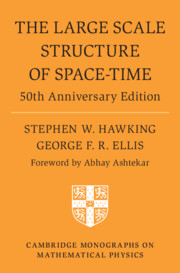Book contents
- Frontmatter
- Dedication
- Contents
- Foreword
- Preface to 50th Anniversary Edition
- Preface
- 1 The role of gravity
- 2 Differential geometry
- 3 General relativity
- 4 The physical significance of curvature
- 5 Exact solutions
- 6 Causal structure
- 7 The Cauchy problem in General Relativity
- 8 Space-time singularities
- 9 Gravitational collapse and black holes
- 10 The initial singularity in the universe
- Appendix A: Translation of an essay by Peter Simon Laplace
- Appendix B: Spherically symmetric solutions and Birkhoff’s theorem
- References
- Notation
- Index
9 - Gravitational collapse and black holes
Published online by Cambridge University Press: 17 February 2023
- Frontmatter
- Dedication
- Contents
- Foreword
- Preface to 50th Anniversary Edition
- Preface
- 1 The role of gravity
- 2 Differential geometry
- 3 General relativity
- 4 The physical significance of curvature
- 5 Exact solutions
- 6 Causal structure
- 7 The Cauchy problem in General Relativity
- 8 Space-time singularities
- 9 Gravitational collapse and black holes
- 10 The initial singularity in the universe
- Appendix A: Translation of an essay by Peter Simon Laplace
- Appendix B: Spherically symmetric solutions and Birkhoff’s theorem
- References
- Notation
- Index
Summary
In this chapter, we show that stars of more than about 1½ times the solar mass should collapse when they have exhausted their nuclear fuel. If the initial conditions are not too asymmetric, the conditions of theorem 2 should be satisfied and so there should be a singularity. This singularity is however probably hidden from the view of an external observer who sees only a ‘black hole’ where the star once was. We derive a number of properties of such black holes, and show that they probably settle down finally to a Kerr solution.
In §9.1 we discuss stellar collapse, showing how one would expect a closed trapped surface to form around any sufficiently large spherical star at a late stage in its evolution. In §9.2 we discuss the event horizon which seems likely to form around such a collapsing body. In §9.3 we consider the final stationary state to which the solution outside the horizon settles down. This seems to be likely to be one of the Kerr family of solutions. Assuming that this is the case, one can place certain limits on the amount of energy which can be extracted from such solutions.
- Type
- Chapter
- Information
- The Large Scale Structure of Space-Time50th Anniversary Edition, pp. 299 - 347Publisher: Cambridge University PressPrint publication year: 2023

